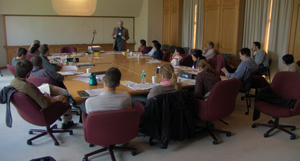
|
|
|
|
|
||
Education Corner: Gary L. GillilandTraining the Next Generation of PDB Depositors: the X-Ray Methods in Structural Biology Course at Cold Spring Harbor Laboratory
The course organizers – Drs. James Pflugrath, Alex McPherson, Bill Furey, and Gary Gilliland – have worked together for more than
fifteen years to develop a unique learning experience that takes advantage of the expertise of many crystallographers that are pioneering
methods in the field. This year's instructors included Drs. Paul Adams, Martin Caffrey, Serge Cohen, Paul Emsley, Morten Kjeldgaard, Gerard Kleywegt,
Leemor Joshua-Tor, Duncan McCree, Randy Read, Dave Richardson, Jane Richardson, Robert Sweet, Tom Terwilliger, Dale Tronrud, David Waugh, and
John Westbrook. The benefits to the participants from an instruction team of this quality are immense. Not only are they learning techniques
that represent the latest innovations in structure determination, but they are also exposed to the thought processes of individuals
who have created the software used in many structure determinations. The CSHL experience is unique in that the students learn and
practice at a fundamental level all of the steps involved in a crystal structure determination.

Prof. Alex McPherson demonstrating the classic macromolecular crystal mounting technique in quartz capillaries used for collecting X-ray diffraction data at room temperature. The 2006 class of sixteen students has successfully completed the 16 day course X-Ray Methods in Structural Biology. Since 1988, students and instructors have descended upon Cold Spring Harbor Laboratory (CSHL) in New York to study the principles of X-ray crystallography. They then apply these concepts to actual structure determinations through extensive laboratory practicals. Each year, students are selected from a large international pool of applicants from academic, private, and commercial research laboratories. Their previous research experience ranges from that of graduate student to laboratory director. During the course, class begins at 9:00 a.m., with the instructors retiring late in the evening while many of the students work on into the night.

Dr. James Pflugrath teaching students the procedures and techniques required for synchrotron X-ray data collection at the Brookhaven NSLS. As the PDB user community knows, macromolecular crystallography yields a wealth of unique structural information that is used to further our understanding of biological systems. But learning the skills needed for structure determinations using diffraction methods is not easy. Crystallographic training is most often done in a research laboratory through what could be considered an apprenticeship approach, often with little formal training. Designed for scientists with a working knowledge of protein structure and function, the X-Ray Methods in Structural Biology course provides those new to the field an opportunity to learn from practicing instructors that are contributing significantly to the current methods of structure determination. The course curriculum was developed to emphasize a hands-on approach that includes crystallizing several proteins and determining one or more structures using state-of-the-art software. This laboratory/computational course focuses on the major techniques used to determine the three-dimensional structures of macromolecules. Topics covered include basic diffraction theory, crystallization (proteins, nucleic acids and complexes), crystal characterization, X-ray sources and optics, crystal freezing, data collection, synchrotron and home-source X-ray data reduction, multiple isomorphous replacement, multiwavelength anomalous diffraction, molecular replacement, solvent flattening, non-crystallographic symmetry averaging, electron density interpretation, molecular graphics, structure refinement, structure validation, coordinate deposition in the PDB and structure presentation.

Prof. William Furey lecturing on the theory behind the methods used to solve the phase problem needed for the structure solution of biological macromolecules. The daily lectures provide the theory and methods used in parallel with the laboratory work in which the students determine a structure. The class crystallizes a variety of proteins, and then determines their diffraction properties on the CSHL home source while learning how to cryopreserve these fragile crystals. After screening the crystals, which they then store under liquid nitrogen, the students take a field trip to the National Synchrotron Light Source at Brookhaven National Laboratory to collect multiwavelength X-ray data. They return with their raw data and process it at CSHL (if not done while at Brookhaven). They then use the processed data to determine phases and calculate electron density maps that are autointerpreted (if the data is collected to an appropriate resolution) using several approaches. The students then apply interactive graphic techniques to complete the model prior to refinement of the atomic coordinates. The refined coordinates are then analyzed by the students to see if they conform to the principles of protein structure. Finally, the students learn what is required for deposition in the PDB archive. This year's class has now joined the ranks of the more than 300 former graduates who have gone on to be significant PDB depositors of coordinates and structure factors. Applications for the next course are due June 15, 2007; please see http://meetings.cshl.edu/courses/c-crys07.shtml for more information.
|
||
©2007 RCSB PDB |